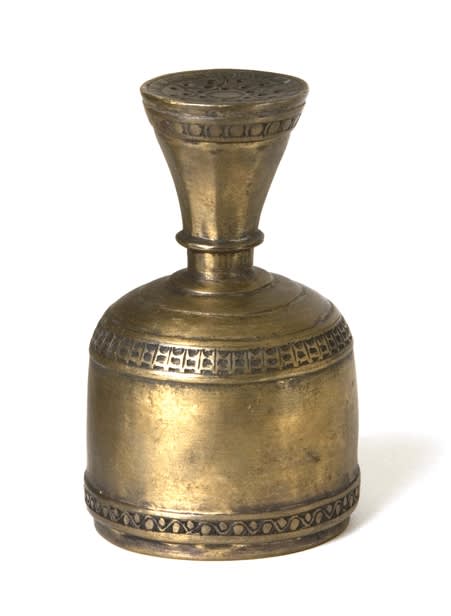Copper Alloy Rose Water Sprinkler, 1100 CE - 1200 CE
Quarternary Bronze
6.125
LO.886
Metalwork in the Near East and Central Asia has always enjoyed a prestige beyond that of other applied arts such as ceramics and textiles. Major pieces were specially commissioned and...
Metalwork in the Near East and Central Asia has always enjoyed a prestige beyond that of other applied arts such as ceramics and textiles. Major pieces were specially commissioned and often bear dedications to the princes and great nobles for whom they were made, together with the proudly inscribed names of their makers and decorators; their very durability and impressive appearance give them a high standing and dignity of their own. The best pieces were in bronze, either engraved, inlaid, overlaid or beaten in repousse', that is hammered out from behind of designs to appear in relief on the surface.
The roots of Islamic metalwork are to be found in Byzantium and Persia. In the early 7th century the Arabs took over these two great empires and absorbed local metal techniques and typologies, and contributed to a new development in metalwork by adding inscriptions in kufic script. Not much is known of the art of metalwork in Persia and Central Asia in the early Islamic period, with the exception of few large dishes datable to the Ghaznavids, until the Seljuq period, when new forms started to appear, while lavish inlays and incrustation of gold, silver and copper crept onto the surface.
This rosewater sprinkler features a cylindrical body, a domed three-stepped shoulder, a constriction and a projecting collar leading to a relatively large splayed neck terminating with a closed perforated mouth, incised in the centre with a small simple roundel encircled by a row of three-pointed designs, possibly resembling a water lily pod. A small band of continuous roundels below the rim. On the upper body, a further band of incised vertical and horizontal strokes, while encircling the lower part, a wave-and-dot patterned band.
This watersprinkler was probably made of high tin bronze- an alloy of copper and about 20 per cent tin. This alloy was known in early Islamic times as asfidroy, literally 'white copper' and was used for bowls, stem bowls, dishes, ewers and candlesticks. Amongst the particular properties of high tin bronze is that it can be red-hot forged, like iron, and if quenched, becomes reasonably malleable when cold. If permitted to cool slowly than hammered, it shatters. Three centres of quarternary bronze manufacture are recorded in Islamic texts of the 10th-11th centuries: Rabinjian near Bukhara, Hamadan in western Persia and Sistan province in eastern Persia. Transoxiana, i.e. Eastern Persia and Afghanistan, provided the inspiration for the Hamadan industry as well and kept on producing high-tin copper alloy vessels well into the 13th century, although with less originality than before.
The quality of engraving and the patterns featured on this water sprinkler would seem to indicate a 12th-13th centuries dating and a Transoxiana provenance.
The roots of Islamic metalwork are to be found in Byzantium and Persia. In the early 7th century the Arabs took over these two great empires and absorbed local metal techniques and typologies, and contributed to a new development in metalwork by adding inscriptions in kufic script. Not much is known of the art of metalwork in Persia and Central Asia in the early Islamic period, with the exception of few large dishes datable to the Ghaznavids, until the Seljuq period, when new forms started to appear, while lavish inlays and incrustation of gold, silver and copper crept onto the surface.
This rosewater sprinkler features a cylindrical body, a domed three-stepped shoulder, a constriction and a projecting collar leading to a relatively large splayed neck terminating with a closed perforated mouth, incised in the centre with a small simple roundel encircled by a row of three-pointed designs, possibly resembling a water lily pod. A small band of continuous roundels below the rim. On the upper body, a further band of incised vertical and horizontal strokes, while encircling the lower part, a wave-and-dot patterned band.
This watersprinkler was probably made of high tin bronze- an alloy of copper and about 20 per cent tin. This alloy was known in early Islamic times as asfidroy, literally 'white copper' and was used for bowls, stem bowls, dishes, ewers and candlesticks. Amongst the particular properties of high tin bronze is that it can be red-hot forged, like iron, and if quenched, becomes reasonably malleable when cold. If permitted to cool slowly than hammered, it shatters. Three centres of quarternary bronze manufacture are recorded in Islamic texts of the 10th-11th centuries: Rabinjian near Bukhara, Hamadan in western Persia and Sistan province in eastern Persia. Transoxiana, i.e. Eastern Persia and Afghanistan, provided the inspiration for the Hamadan industry as well and kept on producing high-tin copper alloy vessels well into the 13th century, although with less originality than before.
The quality of engraving and the patterns featured on this water sprinkler would seem to indicate a 12th-13th centuries dating and a Transoxiana provenance.
